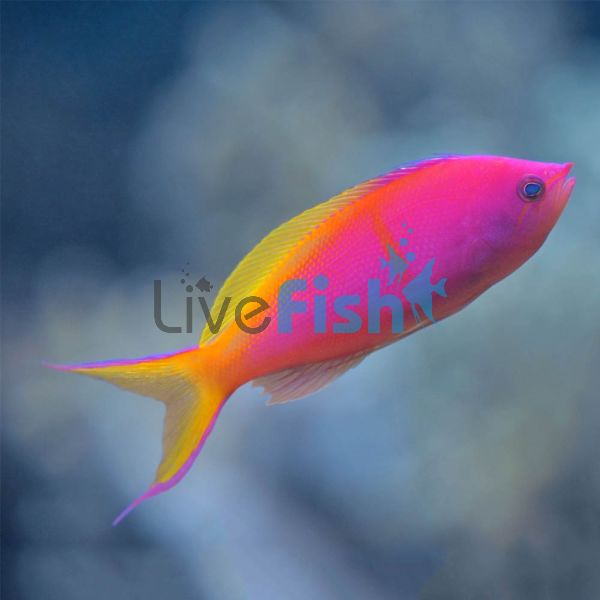Male Threadfin Anthias - Medium
When progressing from a beginner to a more advanced level in the aquarium world, a male Threadfin Anthias is an excellent choice. Stock your tank with some of these handsome swimmers.
The male Threadfin Anthias has a yellow body with a purple field that runs from the top of its head to the bottom of its tailfin. The females are orange-yellow in hue. They are frequently encountered in large groups of thousands of fish in the wild. They do well in groups of one male and multiple females in the tank. Threadfin Anthias are hermaphroditic fish. Which means if the dominant male in your tank dies or is removed, the largest female will transform into a male to take his place.
Males' colours will always be much brighter and more attractive. So, if you're wondering which one is the male and which is the female, you now know how to tell.
In reef tanks, they do rather well. They're from Indonesia, Africa, Maldives so they're used to living in coral reefs, so giving them a familiar environment will help them live longer.
Tank Recommendations for Threadfin Anthias
These lively, colourful fish prefer to be kept in groups of around one male to four females or juveniles. They will spend most of their time in the mid to upper regions of a tank. They can have a difficult time acclimating to a new tank. When another anthias species is present, the process can be sped up. Allow Carberryi Anthias to acclimate for at least 4 hours before releasing them into your aquarium.
Despite its diminutive size, the Carberryi anthias need a large tank. This is owing to the fact that they like to swim and live in open water above reefs. They should not be kept in aquariums that are less than 70 gallons (264 litres) in size. Following the addition of the fish, make sure the aquarium has a tight-fitting lid on it at all times. These fish are known to be jumpers, and when first introduced to an aquarium, they are more inclined to jump.
It's ideal to acclimate your Carberryi Anthia in a deep bucket where the fish won't be able to jump out. Place your fish in the bucket and drip acclimatize at a rate of 3 drips per second for about 45 minutes. This should align the fish's water parameters with those of your aquarium. Catch your fish with a net and gently place it into your aquarium once it has been drip acclimated. It's generally recommended not add any of the water that the fish arrive in to your tank.
Threadfin Anthias prefer an aquarium with a lot of open space to swim in and plenty of small hiding places among live rock. Strong water circulation is essential, but the presence of a few quieter regions where the fish can rest is also useful. They prefer an aquarium that isn't over brightly lit. When keeping Threadfin Anthias, good water quality is critical. pH 8.1-8.4, salinity 1.020-1.025, and temperature 72-78°F (22-26°C) are ideal for Carberryi anthias. They do much better in a larger tank, therefore a 120-gallon (454-liter) tank or larger is recommended.
Suitable Tank Buddies
If the aquarium is large enough, anthias can live in a group with one male and many females; however, if one buys too many, some of the group may perish. If there isn't enough room, the fish at the bottom of the food chain will perish from stress and a lack of food. If one decides to keep a shoal, it's best to keep at least eight, so that any potential hostility is distributed across the group. Different species of Anthias can be kept together to form an Anthias shoal.
Usually Compatible
Threadfin Anthias will thrive in an aquarium with a few less aggressive species such as Dwarf Angelfish, other Anthias, Basslets/Pseudochromis, Blennies, Boxfish, Clownfish, Crustaceans, and Dragonettes . Many other non aggressive fish can also be mixed with Anthias with great effect.
Sometime Compatible
The presence of larger fish like large Angelfish and Surgeonfish will not necessarily doom the Threadfin Anthias. However it may make it more difficult for them to get enough food, and it will likely hinder natural shoaling. When there are larger fish present then Threadfin Anthias are likely to prefer to stay closer to the rockwork. Butterfly, Cardinals, Damsels (including fancy Damsels), Filefish, Rays, Squirrelfish, and Triggerfish are among the many species of fish that you should be able to keep with them in a large enough tank.
Rarely Compatible
These brightly coloured male Threadfin Anthias will be enticing prey for predatory fish. So Sharks, Scorpionfish, Eels, Lionfish and Groupers will all want to eat them. Also predatory invertebrates, such as Ophiarachna species, should be avoided as tankmates.
Feeding your Threadfin Anthias
These fish have unique feeding requirements. Because they graze throughout the day, food should be supplied at least three times per day. Your fish may go hungry if you don't feed them on a regular basis. They prefer frozen and live foods, although some will eat flaked items.
The diet is similar to that of other Anthias species, consisting of zooplankton and floating filamentous algae. Mysis shrimp, vitamin-enriched brine shrimp, frozen preparations, and other meaty products for zooplankton feeders should be fed in the aquarium. They prefer to be fed modest amounts frequently throughout the day.
| Scientific Name | Nemanthias carberry |
|---|---|
| Care Level | Moderate |
| Common Names | Threadfin Anthias |
| Diet | Carnivore |
| Fish Family | Serranidae |
| Lifespan (years) | 4 |
| Max. Length (cm) | 12.5 |
| Min. Tank Volume (l) | 318 |
| Origin | Indonesia, Africa, Maldives |
| Reef Safe | Yes |
| Sociability | Peaceful |
| Venomous | No |
| Water Conditions | 22°C to 27°C pH: 8.1 to 8.4 |




